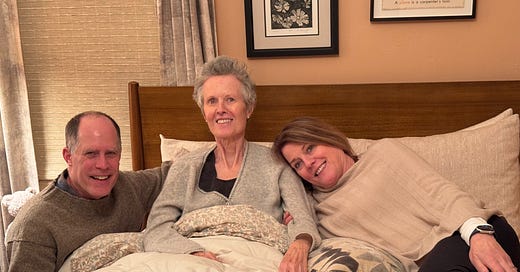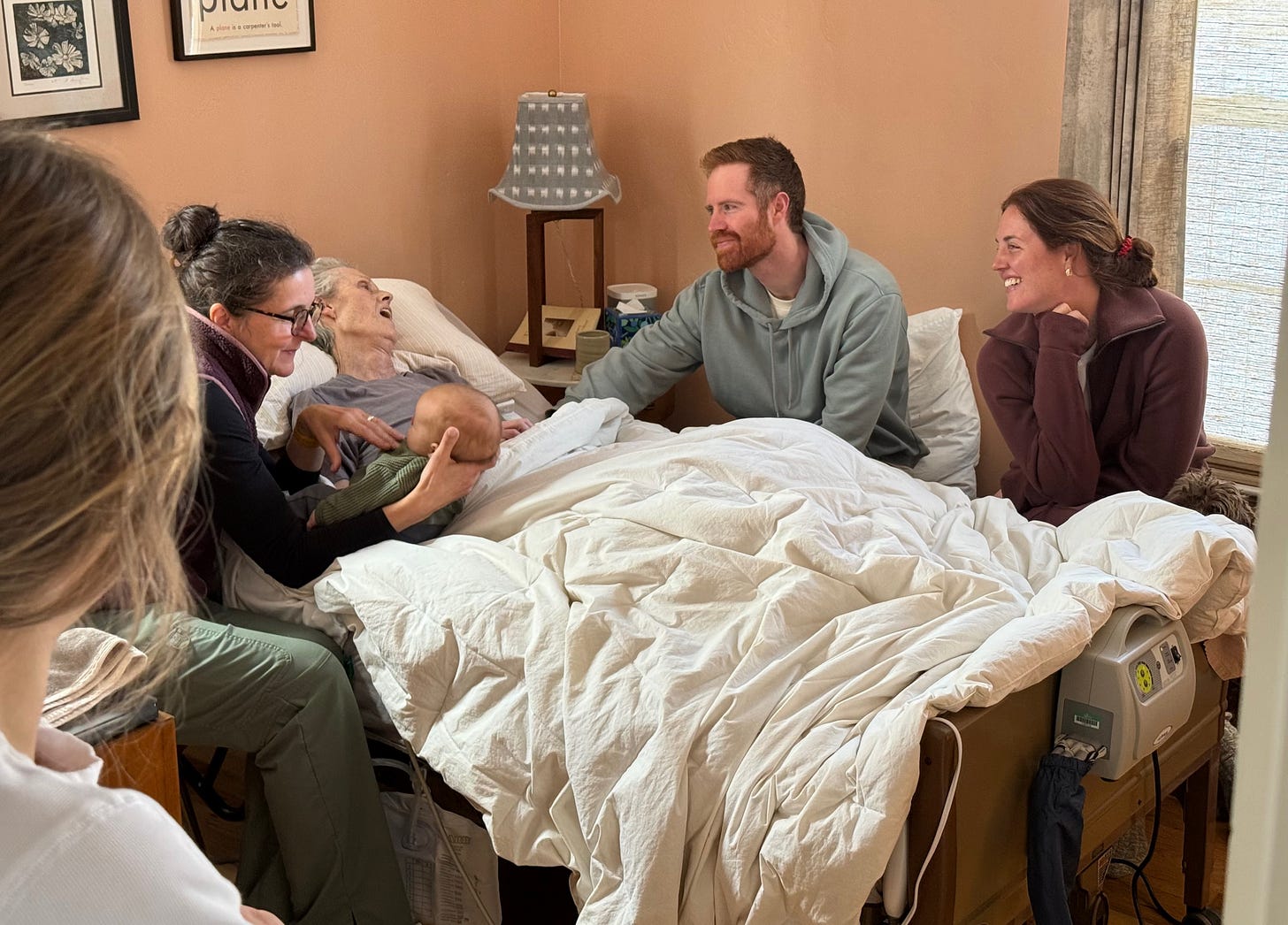I was never entirely comfortable with the word “caregiver” applied to my relationship to Julie during her illness. I certainly cared for her and loved her through all of it but my relationship was more like that of a close companion sharing a hard journey. Julie was very much herself and managed her medical care through all of it, including the decision to end cancer treatment and start hospice care.
Julie took her last dose of zongertinib on February 1 and started home hospice care on February 4. During all of her cancer treatment, she kept a daily log of her medications. February 6 was the first day in that log when the flow of her distinct script was broken by my printing.
The evening Julie started home hospice care, one of the staff from St. Luke’s Hospice rang the front door bell and presented a box full of drugs. The new reality of caregiving hit me. While I had backup and support from the hospice team, now I was the one responsible for ensuring that Julie took the right medications in the right quantity at the right time and that she had help with the basics of life.
Julie, brother Scott, and sister Robin on February 6, 2025
Hospice nurses focus first on managing the three Ps: pain, poop, and pee. Julie’s cancer induced pain from her nerves, vascular system, and bones. The hospice nurse recommended methadone to provide baseline pain relief and oxycodone and then morphine for breakthrough pain. Many people think of methadone primarily as a treatment for heroin addiction but it was originally designed for pain relief. It effectively treated all of the sources of Julie’s pain and also allowed her to stay more lucid than if treated primarily with morphine.
Most pain medications cause constipation so finding the right mix and dosage of laxatives was essential for Julie to keep her bowels from becoming an additional source of pain and suffering. A combination of the maximum dose of the natural laxative senna and Miralax kept everything moving through the way it should as Julie’s body began to shut down and she ate less and less.
By February 10, Julie was unsteady on her feet and every trip to the bathroom required help or risked a bad fall if she tried to go on her own. Julie would have the urge to relieve herself at night and would try to get up on her own and I would have to rush to help. Some hospice patients will use an adult diaper but Julie sustained a strong urge to get up to use the bathroom. Gudrun, the hospice angel, arrived for the first time on the 12th and installed a catheter which allowed Julie and me to rest easier.
Margot stayed at the house that night to help. Robin stayed with us the night of the 13th. That evening, Julie’s breathing changed and it was clear she was close to the end. Early morning calls to the 24-hour hospice line helped guide the dosing of medications to keep Julie as comfortable as we could.
Gudrun arrived early the morning of February 14 and affirmed that we had done everything right. Margot, Daniel, Burgess, Ksenia, and baby Emory gathered to be with Julie in her last hours. Gudrun was trained as a pediatric nurse in Germany and as we all sat around Julie in the warm sunlight of our bedroom, the most amazing thing happened. Gudrun asked to hold Emory and began to talk to him in German in the high-pitched voice that is universal when adults hold infants. She said “Oh, look at you! You are such a little sweetie! Come here and sit with your Grandma. Come and sit with your Oma!” It was a moment of pure transcendent love and joy that bound all of us in the circle of life and death.
Daniel Molloy took this picture a few hours before Julie died
Julie died at 12:05 pm surrounded by Margot, Daniel, Burgess, Ksenia, Robin and me (Emory was napping). Gudrun returned after leaving us for Julie’s last two hours and certified her death at 1:10 pm.
Gudrun, Robin, and Margot then performed the ancient ritual of preparing Julie’s body. Gudrun removed the catheter, they anointed her body with lotion one last time, and then dressed her in lovely and comfortable clothes with a colorful scarf. When they finished, Gudrun said it was time to call the funeral home. Not long afterward the funeral director and his assistant arrived to take Julie’s body. Their wheeled cart couldn’t fit through our narrow hallway. So the assistant and I wrapped Julie in a sheet, carried her through the house, and placed her on the cart outside our front door. Then they drove her away in a van; ten days later came the call to say I could come collect her ashes.
There were a few moments during those ten days of hospice care when Julie seemed distressed, when the medication wasn’t keeping pace with her pain. Those were the hardest for me, when I wished someone else was responsible. But over the course of two weeks, those episodes were brief; most of the time Julie was at rest and comfortable.
I am tremendously grateful that home hospice care allowed Julie to have the death she wanted: peacefully, at home, surrounded by our love.
In my first e-mail newsletter last week, I mistakenly said that you needed to click the subscribe button to keep getting this newsletter if you had been receiving the CaringBridge notices. I learned that I had actually automatically signed up all those on Julie’s CaringBridge to this newsletter. So if you don’t want to get these missives from me, you can unsubscribe.





I am honored that you’ve shared Julie’s end of life moments with us. I’m also amazed by your courage through everything. There are no words to express.
Be well dear Daniel.
You bring her death so vividly to life ♥️♥️